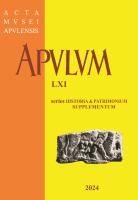COMPLETĂRI ȘI CORECTĂRI LA ISTORIA INCUNABULELOR DIN ORADEA. TREI INCUNABULE ÎN COLECȚIILE BIBLIOTECII JUDEȚENE „GHEORGHE ȘINCAI” BIHOR
Additions and Corrections to the History of the Incunabula in Oradea. Three Incunabula in the Collections of the ”Gheorghe Şincai” Bihor County Library
Author(s): Silviu SanaSubject(s): History, Cultural history, Middle Ages, 15th Century
Published by: Muzeul National al Unirii Alba Iulia
Keywords: incunabula; Oradea; Bihor County Library; additions; Defensorium Curatorum; Robertus Caracciolus; Fasciculus Temporum;
Summary/Abstract: The Romanian specialized literature dedicated to incunabula on the territory of Romania is not so old, although this year marks 59 years since the appearance of the first articles addressing our subject. In a first phase, the research focused on identifying them in various collections of old books from public collections (libraries and museums), that entered the state patrimony by confiscation, both from the collections of abusively suppressed ecclesiastical institutions (Roman-Catholic Church, Greek-Catholic Church) and from various private collections. For Bihor County, research on incunabula accumulated minimal efforts, especially during 1965-1990, when the discovery and promotion of specimens owned by the "Gheorghe Șincai" Bihor County Library by the former director of this institution, Professor Ioan Lenghel, took place. Only after 1990, more precisely in 2005, András Emődi, a recognized specialist in old books, managed to bring to light and capitalize the incunabula collection of the Library of the Roman-Catholic Diocese of Oradea. Thus, for the copies held by the "Gheorghe Șincai" Bihor County Library, a new approach to incunabula research becomes necessary for them to be classified in the "Treasure" category of the National Cultural Heritage of Romania. Their analysis not only completes new data, but also corrects some errors/gaps mentioned in the bibliography works that addressed the Oradea copies. The present study wants to bring additions to the history of these incunabula from Oradea, thus contributing to completeness both from a bibliophile and historical point of view of the three patrimonial values. The three incunables are Defensorium curatorum contra eos qui privilegiatos se dicunt. Add: Pius II: Epistola ad Ludovicum XI Francorum regem ad quassationem Pragmaticae Sanctionis, Paris, [1489-1492], Robertus Caracciolus, [Opera Varia], Venice, [Non post 1485], [Fasciculus Temporum Omnes Antiquorum Cronicas Complectens], Venice, [1479]. For the volume Defensorium Curatorum, Paris [1489-1492] the information that completes the specialized bibliography is: it is the 7th edition out of the 8 known, only 9 copies of this edition being known in the world. The copy has historical value because it serves to know the political and theological context of the XIV-XV centuries, directly the dispute between parish priests and medicants orders, as well as the political-diplomatic relations between the Holy See of Rome and the Court of the King of France. The copy is a direct testimony to the work of one of the most famous Roman Catholic bishops, Richardus Fitzralph (1295-1360) and then to the work of Pope Pius II (1405-1464). The copy distinguishes by a very good execution, printed in Latin, on a column, in black ink, on paper with watermark, having a coat of arms of the royal court of France. For the work Fasciculus Temporum, Venice 1479 the new information is as follows: In 1975, Professor Ioan Lenghel mentioned that the leaves are without number ("non-paginated"), this information being false. In 2007, false information was also given, the catalog written by Schatz and Stoica mentioned that the copy has the following pagination: leaves 1-25, 64-68, 70-71. The copy is incomplete, with a total of 39 leaves (leaves 26-63). Other new information relates to notes. The book has 157 handwritten notes, of which 29 are decipherable and whole. The copy has historical value because it serves to know the conceptions of the fifteenth century, regarding the historical, theological, political and social knowledge of universal history, from the "creation of the world" until 1471. The particularity of this work is given by the parallel chronology of universal history and ecclesiastical history, of Roman Catholic Church. The copy is a direct testimony to the work of the Carthusian monk, Werner Rolevink (1425-1502) from Köln, a German historian and theologian, whose fundamental work is the present work.For Robertus Caracciolus Opera Varia, Venice [non post 1485] the new information is as follows: this is the third edition of the 6 known to be incunabula. The work contains 79 sermons with themes from the liturgical calendar, concerning the morals and dogmatic teaching of the Church, numbered by manuscript note ”Sermo 1, 2, 3, ...”. The specimen is in relatively good conservation condition, some leaves (from the beginning) show traces of stains. Leaves 8-9, 27-32, 156-164, 197-204 show traces of biological degradation, that is, traces of worm holes. The copy has historical value because it serves to know the printing activity in Venice, being at the same time a historical testimony of the homiletic literature of the fifteenth century in the Roman Catholic Church. The copy is a direct testimony to the printing activity of Gabriel of Grassis of Venice and especially to the work of Bishop Robertus Caracciolus, one of the most famous preachers of the fifteenth century.
Journal: Apulum
- Issue Year: 61/2024
- Issue No: 1
- Page Range: 203-218
- Page Count: 16
- Language: Romanian
- Content File-PDF

